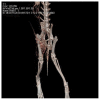Transplantation of vascular endothelial growth factor 165‑transfected endothelial progenitor cells for the treatment of limb ischemia
- PMID: 26239164
- PMCID: PMC4581802
- DOI: 10.3892/mmr.2015.4100
Transplantation of vascular endothelial growth factor 165‑transfected endothelial progenitor cells for the treatment of limb ischemia
Abstract
The present study aimed to investigate the effects of neovascularization in rabbits with limb ischemia transplanted with vascular endothelial growth factor (VEGF)165‑transfected endothelial progenitor cells (EPC). Bone marrow mononuclear cells were isolated by gradient centrifugation, cultured in M199 culture medium and induced into EPCs using VEGF, basic fibroblast growth factor, and insulin‑like growth factor‑1, and subsequently identified. The EPCs were transfected with Adv‑green fluorescent protein‑VEGF165 and the proliferation potential of the cells was determined using an MTT assay. The protein expression levels of VEGF were measured by detecting its concentration levels in the supernatant using an ABC‑ELISA assay. A rabbit hind limb ischemic model was established and randomly divided into three groups: (A) Control group, (B) EPC‑transplanted group, and (C) Ad‑VEGF165/EPCs‑transplanted group. The effects of transplantation and the levels of recanalization were detected. Incorporation of the transplanted cells into the ischemic region was confirmed by 5‑bromodeoxyuridine staining, and the levels of recanalization were measured by computer tomography ateriography and immunohistochemical staining. Bone marrow‑derived EPCs were induced, cultivated, and successfully identified. The results of the present study determined the optimum transfection ratio that promoted the growth of EPCs. The EPCs were successfully transfected with VEGF165, and EPC proliferation was not affected by the transfection. The supernatant protein concentration levels of VEGF were markedly higher in the VEGF165‑transfected group, as compared with those of the control group. Introduction of the transplanted cells into the ischemic region of group C occurred more efficiently, as compared with groups A and B. The recanalization capillary density in group C was significantly higher, as compared with groups A and B. VEGF gene transfection was able to improve the quality of EPCs, and the response of rabbits with limb ischemia to transplantation with VEGF‑transfected EPCs was significantly better, as compared with transplantation with EPCs alone.
Figures










Similar articles
-
Transplantation of VEGF165-gene-transfected endothelial progenitor cells in the treatment of chronic venous thrombosis in rats.Chin Med J (Engl). 2010 Feb 20;123(4):471-7. Chin Med J (Engl). 2010. PMID: 20193489
-
The therapeutic effect of vascular endothelial growth factor gene- or heme oxygenase-1 gene-modified endothelial progenitor cells on neovascularization of rat hindlimb ischemia model.J Vasc Surg. 2013 Sep;58(3):756-65.e2. doi: 10.1016/j.jvs.2012.11.096. Epub 2013 Apr 4. J Vasc Surg. 2013. PMID: 23562340
-
Combination of stromal-derived factor-1alpha and vascular endothelial growth factor gene-modified endothelial progenitor cells is more effective for ischemic neovascularization.J Vasc Surg. 2009 Sep;50(3):608-16. doi: 10.1016/j.jvs.2009.05.049. Epub 2009 Jul 12. J Vasc Surg. 2009. PMID: 19595531
-
Transplantation of Endothelial Progenitor Cells: Summary and prospect.Acta Histochem. 2023 Jan;125(1):151990. doi: 10.1016/j.acthis.2022.151990. Epub 2022 Dec 30. Acta Histochem. 2023. PMID: 36587456 Review.
-
Circulating Endothelial Progenitor Cells Biology and Regenerative Medicine in Pulmonary Vascular Diseases.Curr Pharm Biotechnol. 2018;19(9):700-707. doi: 10.2174/1389201019666181017161752. Curr Pharm Biotechnol. 2018. PMID: 30332949 Review.
Cited by
-
Enhanced penetration of exogenous EPCs into brains of APP/PS1 transgenic mice.Am J Transl Res. 2016 Mar 15;8(3):1460-70. eCollection 2016. Am J Transl Res. 2016. PMID: 27186272 Free PMC article.
-
VEGF-A and FGF4 Engineered C2C12 Myoblasts and Angiogenesis in the Chick Chorioallantoic Membrane.Biomedicines. 2022 Jul 23;10(8):1781. doi: 10.3390/biomedicines10081781. Biomedicines. 2022. PMID: 35892681 Free PMC article.
-
Randomized clinical trial of physiological ischemic training for patients with coronary heart disease complicated with heart failure: Safety of training, VEGF of peripheral blood and quality of life.Exp Ther Med. 2018 Jul;16(1):260-264. doi: 10.3892/etm.2018.6175. Epub 2018 May 17. Exp Ther Med. 2018. PMID: 29896247 Free PMC article.
-
Gene Therapy for Cardiovascular Disease: Clinical Perspectives.Yonsei Med J. 2024 Oct;65(10):557-571. doi: 10.3349/ymj.2024.0127. Yonsei Med J. 2024. PMID: 39313446 Free PMC article. Review.
References
-
- Kang HC, Kim DS, Kim JY, Kim HS, Lim BY, Kim HD, Lee JS, Eun BL, Kim DW. Behavioral improvement after transplantation of neural precursors derived from embryonic stem cells into the globally ischemic brain of adolescent rats. Brain Dev. 2010;32:658–668. doi: 10.1016/j.braindev.2009.09.010. - DOI - PubMed
-
- Zhou Y, Singh AK, Hoyt RF, Jr, Wang S, Yu Z, Hunt T, Kindzelski B, Corcoran PC, Mohiuddin MM, Horvath KA. Regulatory T cells enhance mesenchymal stem cell survival and proliferation following autologous co-transplantation in ischemic myocardium. J Thorac Cardiovasc Surg. 2014;148:1131–1137. doi: 10.1016/j.jtcvs.2014.06.029. - DOI - PMC - PubMed
MeSH terms
Substances
LinkOut - more resources
Full Text Sources
Other Literature Sources

